Creative Teaching Resources for
by Eric P. Kelly (1928)
LitWits Activities, Takeaway Topics, Prop Ideas, and Learning Links
In 15th-century Poland, Joseph Charnetski and his family flee their country home for Krakow, pursued by an evil Tartar who wants to steal their Great Tarnov Crystal. The scientist-scholar Jan Kanty helps them find housing, and gets the father a job as the trumpeter at St. Mary’s—a legendary role. Despite their vigilance, an alchemist steals the crystal, believing it to be the Philosopher’s Stone, and fire and brimstone ensue! (Really!) Filled with excitement and intrigue, this story shows us what it means to be noble, and conveys the dangers of misusing power.

ACTIVITIES ON THIS PAGE:
Meet the author
Get your bearings
Write a new description of the villain
Taste medieval market fare
Retrace the travels of the Great Tarnov Crystal
Draft a job ad for a trumpeter
Define architectural terms
Sketch the ending of the Heynal
Do a little alchemy
Make a fiery mask
Transmute brass into gold!
Review plot points on the narrative arc
Wrap it up!
ON THIS PAGE:
Printables: preview of worksheets and activity printables for sale
Takeaway Topics: teaching points made meaningful through activities
Prop Ideas: story objects that make abstract ideas more memorable
Learning Links: curated external links for lesson prep or tangential learning
Terms of Use: how you may use LitWits® resources
LitWits makes a small commission on supplies or books you buy through our Amazon affiliate links.
Creative Teaching Idea #1
Without the author and his life experiences, The Trumpeter of Kraków would never have been written, and Poland's now-famous legend would have faded into obscurity! Introduce your kids to Eric P. Kelly through our short video, which shares kid-friendly, interesting aspects of his life.
You’ll find a worksheet for author note-taking and conversation-starting in our printables set.
Creative Teaching Idea #2
Before jumping into the story, help your kids discover its setting, and learn a little bit about the place. That's easy when you show them this short video tour of Krakow, and find Poland on the map worksheet included in our printables set.
Creative Teaching Idea #3
In the book, Peter's face is described as evil based on his features. Using our creative writing worksheet, your kids will rewrite that stereotypical description to show his badness through his actions, which he's actually responsible for.
For instance:
his lip was curled up in a snarl
his forehead was wrinkled by a scowl
he snapped at the boy
he whipped his horse mercilessly
Scroll for more, or browse other titles.
Creative Teaching Idea #4
This "BookBite" inspiration comes from the description of Krakow Market Day in Chapter 2. A baker’s boy is mentioned, which is all the excuse needed to serve a beautiful rustic bread, and the singing Armenian merchants were among the many who would have sold exotic edible items, most certainly including dates and figs.
While the kids eat, play some Armenian chants and the hejnal mariacki.
Creative Teaching Idea #5
The Great Tarnov Crystal has a thrilling history, and it's a lot of fun to reenact its saga (as told in Chapter 15 by Bogdan the Terrible). And it’s a chance for kids to pick up a little geography, too! Following your prompts, they'll sneak the crystal from person to person, hamming it up as each character all throughout Europe. For instance:
You are Babu the Tartar. Look intently for the crystal at Tarnov. Become angry that you can’t find it! Go back from whence you came.
Supplies and directions are below. The name tags, place tags, and prompts are included in our printables set.
an object to represent the Tarnov Crystal, like this 8" garden gazing ball
a “pumpkin” in which to hide the crystal – easiest to find at a craft store at Hallowe'en. (Ours was foam and we carved a lid.) Otherwise, use an orange bag, or wrap your (nonbreakable) crystal in orange fabric and tie it up in a green ribbon knot.
In our printables set:
prompts
name tags
location signs
OPTION: If it's fall and mini-pumpkins are available, it's fun to carve lids and insert a small crystal in each one—then have the kids empty the seeds with a spoon, and watch their faces as they find their own mini Great Tarnov crystals!

LitWits makes a small commission on supplies or books you buy through our Amazon affiliate links.
1. Gather your group, maps in hand, in the approximate center of your space and announce that you’re all standing in Warsaw, Poland. Help the kids find Warsaw on their maps, then determine which way is north.
2. From this point, use the map to figure out where to tape the sign for each site. For instance, since you are facing north, you should tape the sign for “The East,” on the left hand side of the room. For “Egypt,” tape the sign on the farthest wall behind you, etc.
3. Put the pumpkin in “The Ukraine.”Hand everyone a name tag, and ask the kids to go stand at the places indicated on their tags.
4. Read the #1 prompt for the child with the #1 nametag. (Using a dramatic voice yourself will encourage dramatic flair!)
5. Proceed through the prompts, one location and individual at a time, having the kids act out the tasks and expressions associated with their characters.
Encourage hamminess, but tell the kids that it’s very important to keep the crystal hidden the entire time — no Great Tarnov Crystal carekeeper is never safe!
If it's pumpkin season, you might want to reward each actor with a Not-so-Great Crystal (ornament) hidden inside a mini pumpkin. It's a little extra work, but the kids will LOVE it.
Scroll for more, or browse other titles.
Creative Teaching Idea #6
The job of Trumpeter for the City of Krakow has just opened up — let’s hope the Tartars weren’t to blame! The position needs to be filled immediately, for safety’s sake!
Drafting a “help wanted” ad gets kids thinking about just what it takes to be The Trumpeter of Krakow, which quietly teaches them about the craft of characterization. The legendary trumpeter of 1241, Pan Andrew, Joseph, and all the "real" trumpeters of Krakow had (and still have) to be pretty special.
Photo credit Trumpeter playing the Hejnał Mariacki (St. Mary's, Kraków). - Wikipedia
Tell your kids that as employees of the City of Krakow's Human Resources department, they must post an ad for a replacement trumpeter in the Warsaw Chronicle. They'll need to:
give a brief job description (share the actual requirements for today's trumpeters of Krakow—it's not an easy job!)
explain the salary and benefits
list the type of personality and skills required (brave, strong, 20/20 vision, can climb almost 300 stairs daily, can tolerate repetition)
draw an eye-catching illustration
The cross-era newspaper template is in our printables set.
Creative Teaching Idea #7
How dazzled Joseph is by Krakow's old architecture as he walks to work with his dad! He admires pinnacles and gargoyles and buttresses galore—and more!
Help your kids figure out what's what in medieval Polish architecture, using our visual vocabulary worksheet.
Scroll for more, or browse other titles.
Creative Teaching Idea #8
On his first day of work, Pan Andrew makes a big point of telling Joseph how important it is that he too knows how to play the heynal—just in case.
He uses a piece of charcoal to sketch the notes on a piece of parchment, and tells Joseph to write it and sing it until he knows it well. Your kids can do the same—and learn some basics of sheet music, too! Those kids who play an instrument will be happy to share their knowledge of notes and rests.
You'll just need a piece of charcoal (or a black crayon) and a piece of parchment, which you'll find in our printables set (tear off the edges).
Creative Teaching Idea #9
"I am an alchemist, one who seeks the truth . . . I mix vinegar and sugar and soda, and there is immediately a bubbling and a change. Something new is created."
—Nicholas Kreutz, Ch. 7
This story begs a science experiment! We’ve learned the book’s lesson about playing with fire, though —no melting metals for us! For a simple, safe, sensory, straight-from-the-story experience of Kreutz’s “search for truth,” combine the classic twosome of vinegar and baking soda. The kids will be thrilled by the fabulous sizzle and froth!
To create a medieval mood while you’re doing this, dim the lights, play Latin chants, use something brazier-ish to hold the baking soda, and pour the vinegar from an old bottle or flask.
Scroll for more, or browse other titles.
Creative Teaching Idea #10
The alchemist Nicholas Kreutz fends off Peter of the Buttonface and his henchmen in a blaze of—well, more phosphorous than glory, but it works! Amazingly, glow paint and tissue paper work just as well.
While the kids recreate Kreutz's fiery mask, you can talk about characterization techniques. For instance, the alchemist's actions show us he has courage, and can put his skills to use for good. But then he took the crystal and kept it, right? So he's also vulnerable to greed and is willing to steal. What else do we learn about Nicholas Kreutz in this scene?
The mask template and theme worksheet are included in our printables set.
glow-in-the-dark paint and paintbrush
black construction paper
the mask template (in our printables set)
about 3' string or twine (for tying mask around the head)
glue stick
scissors
pencil
hole punch
LitWits makes a small commission on supplies or books you buy through our Amazon affiliate links.
Glue the mask template to the black construction paper and cut it out.
Use a hole punch for the side holes and a pencil for the eyes. Yikes!
Turn the mask over and draw the eyes.
Paint them with phosphorata (glow paint) and attach twine to the side holes.
Apply glue to the mask in patches and attach tissue paper, gathered into tufts or cut into strips, to make flames.

Distribute the theme worksheet (in our printables set). Tell the kids a theme is always found just underneath the story, not right on top. Besides the obvious meanings we’ve already talked about, we need to think about what fire and light stand for — what they represent, orsymbolize:
What does fire stand for? (Passion, enthusiasm, power, energy, the violence of nature, the body, hell, evil.)
What does light stand for? (Knowledge, awareness, power, energy, the beauty of nature, the spirit or soul, heaven, goodness.)
What do they have in common? (Both fire and light symbolize power and energy.)
When we find a common meaning between two symbols, we’re hot on the trail of a theme. We’re on fire! We’ve seen the light! If fire and light can be misused, so can power and energy. In this book, power can be very dangerous. Aha — there’s the theme!
Creative Teaching Idea #11
It's the moment everyone's been waiting for: the chance to turn brass into gold!
Of course, FIRST your kids will have to gaze into the crystal and use their newly made quill pens to rewrite the ancient formula on the scroll they see there! While they do this project, you can discuss the misuse of the alchemist's skills—and what kinds of ideas cn turn ambition to greed.
You'll find the scroll parchment and band in our printables set.
SUPPLIES PER CHILD
For quill pen:
For scroll:
parchment printed with formula (in our printables set)
parchment band with quote (in our printables set)
For transmutation:
glue stick
LitWits makes a small commission on supplies or books you buy through our Amazon affiliate links.
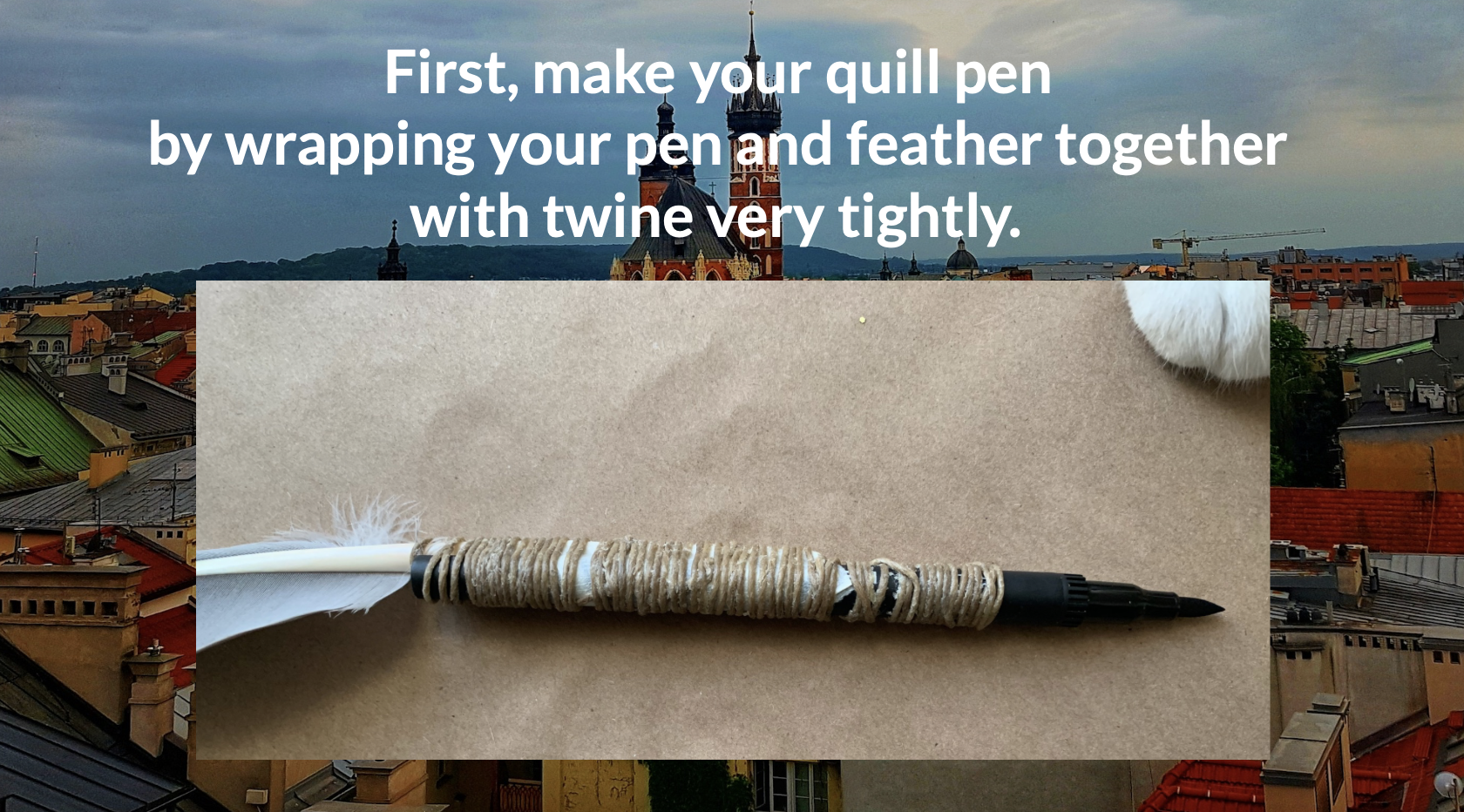

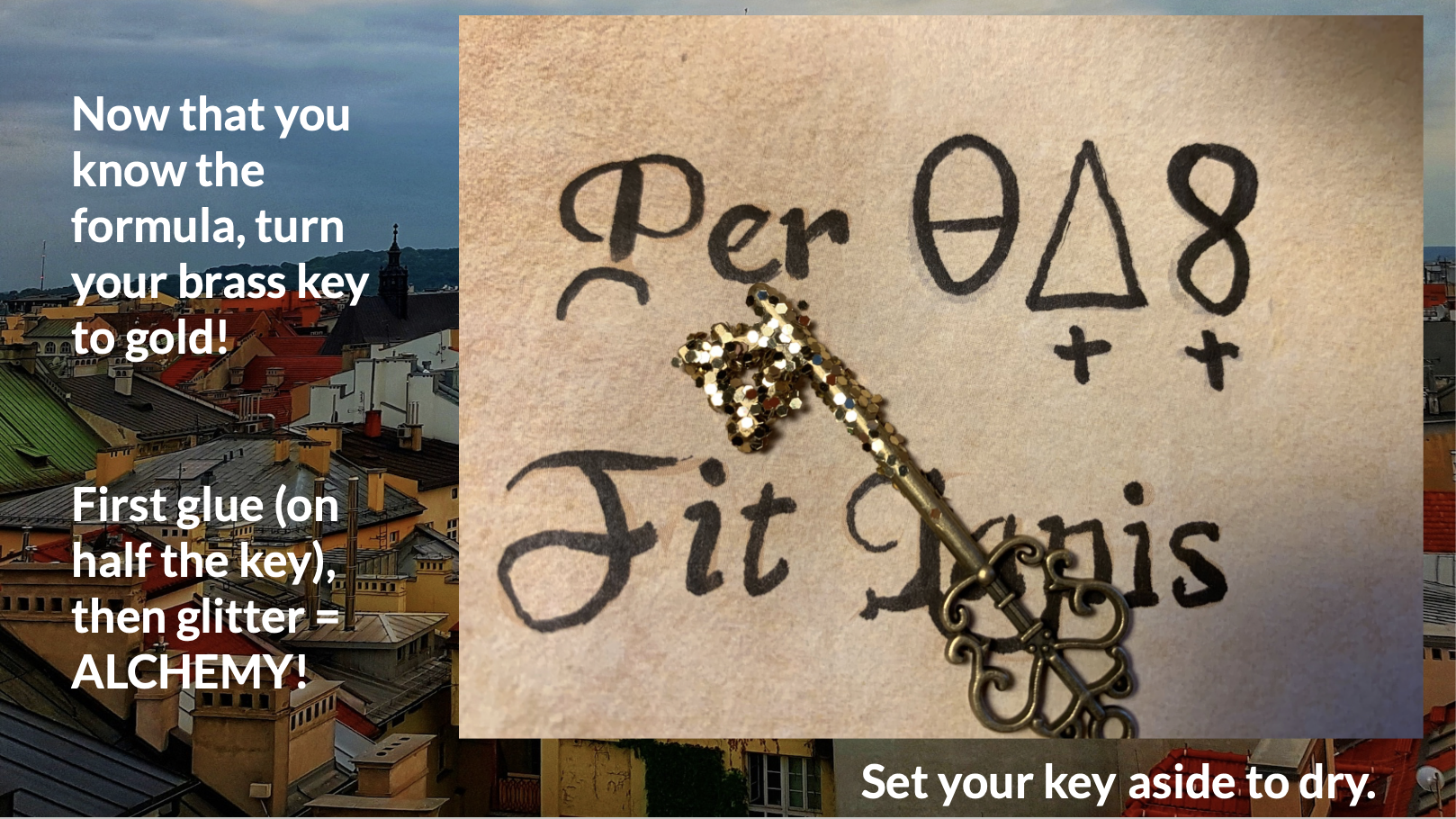
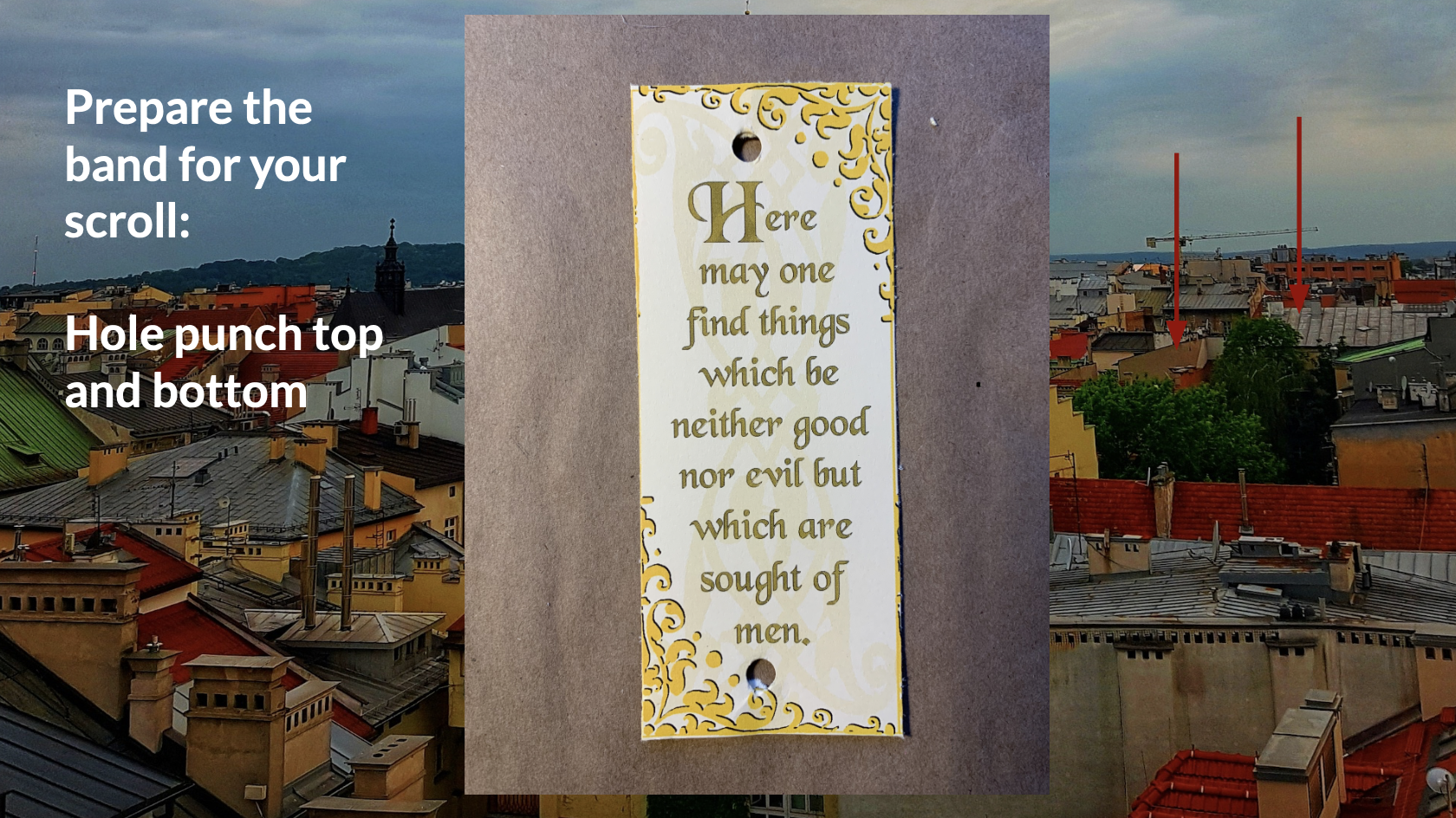
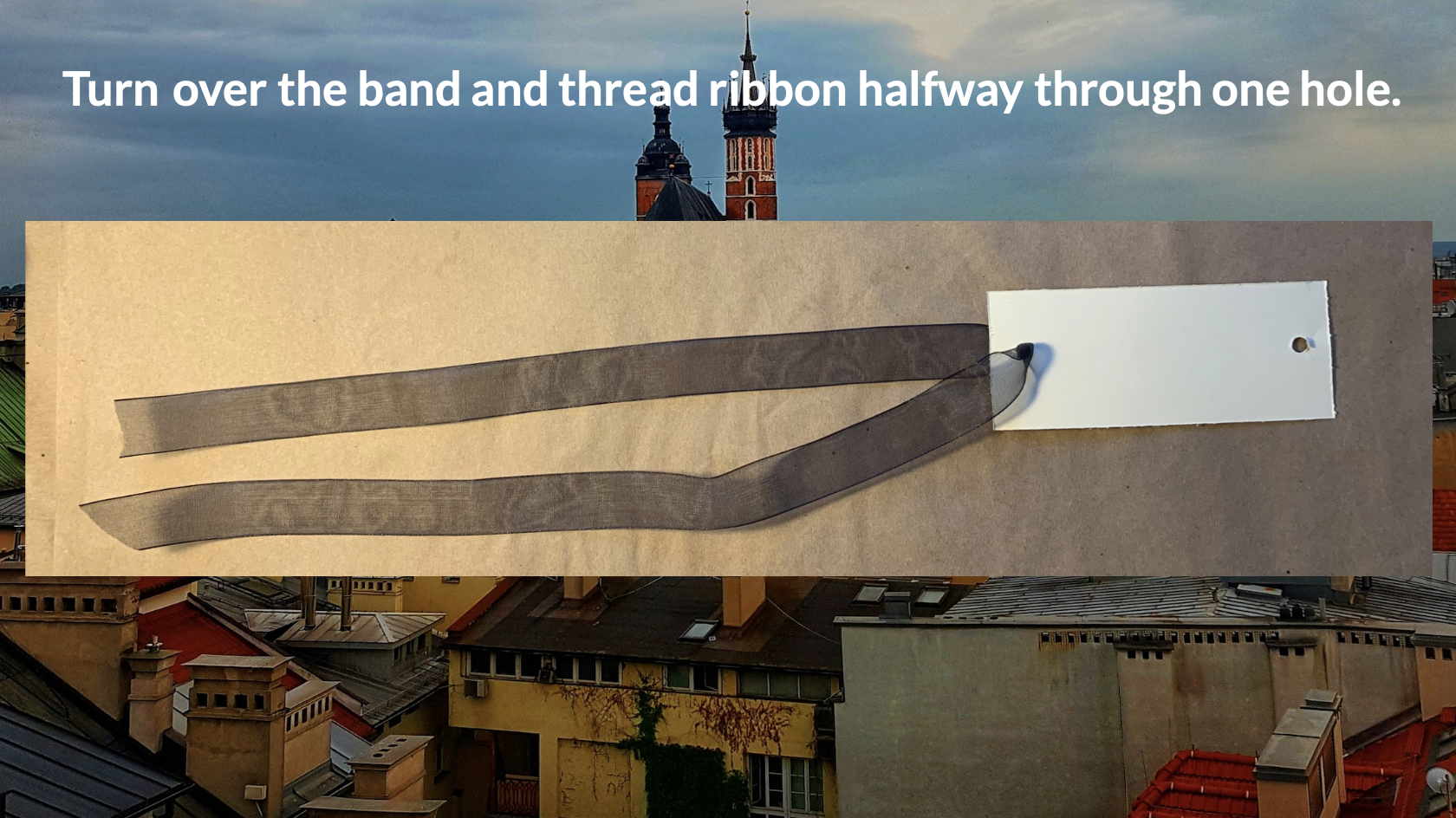
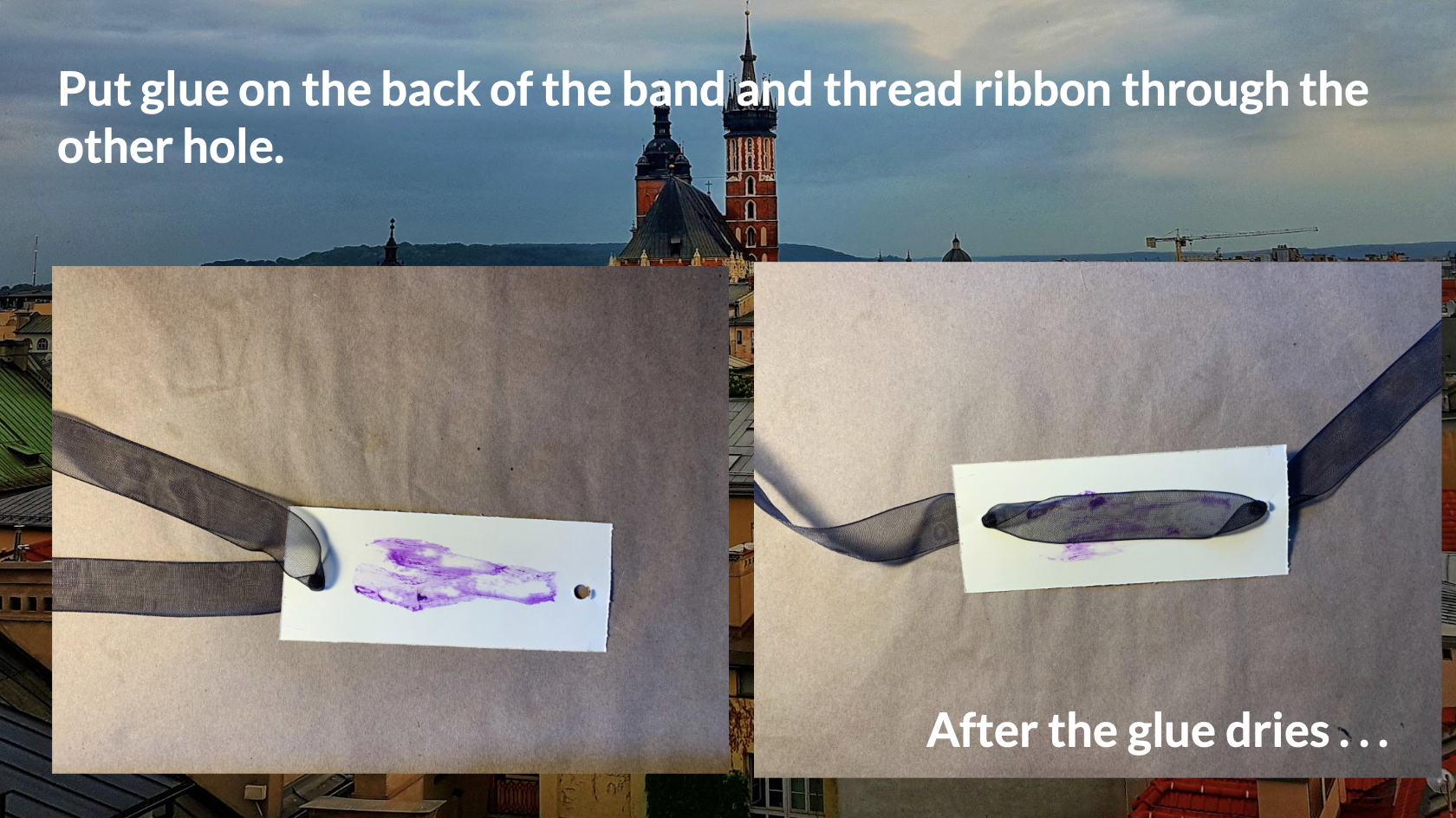
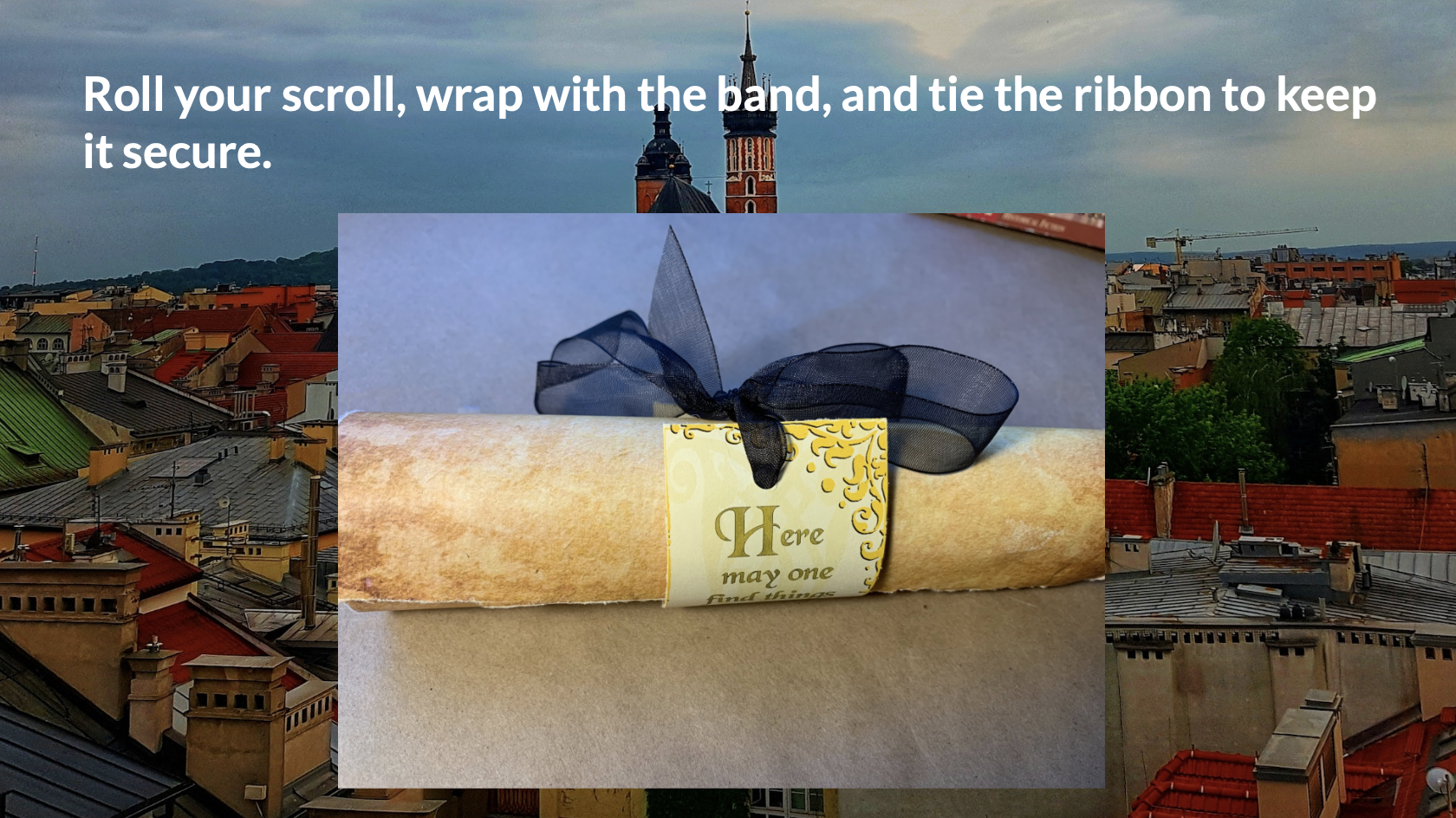
To "transmutate" the brass key, dip it in glue, then into glitter.
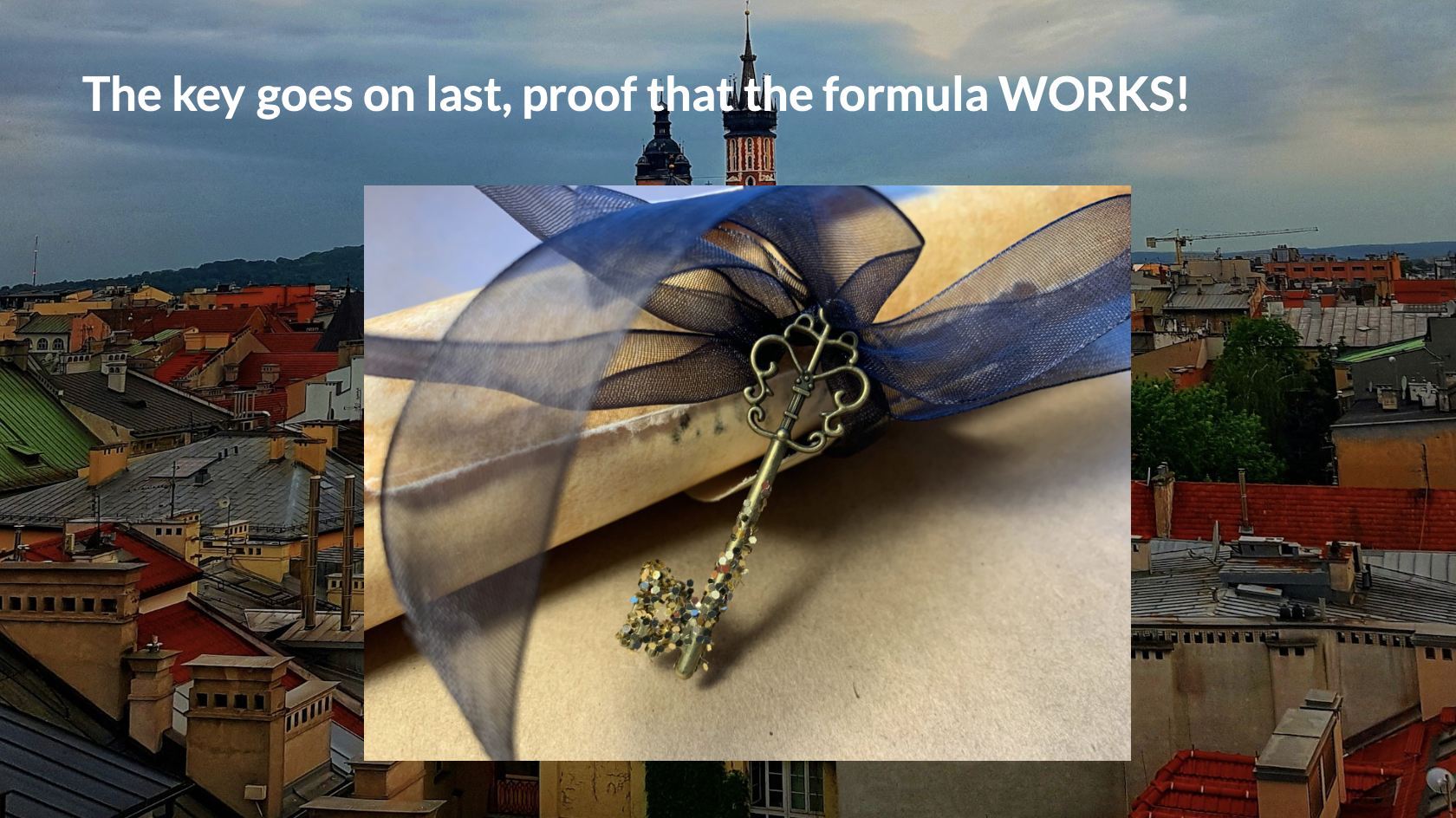
Scroll for more, or browse other titles.
Creative Teaching Idea #12
Help kids learn the important concept of story order (useful for all communications!) and see how Eric P. Kelly arranged The Trumpeter of Krakow. You can discuss and/or do our narrative arc worksheet in any of these three ways:
At the end of your activities, introduce the concept of the narrative arc, then help kids figure out where the different parts of this story fit on it.
OR introduce the concept and complete the worksheet before the activities, so kids have a review of the story fresh in their heads first, and you can remind them "where we are" on the arc as you go.
OR introduce the concept up front, but save the story's scenes to discuss as you go, pausing to "do what the characters did" in fun hands-on ways, while weaving in discussions and other worksheets.
Creative Teaching Idea #13
You've just taken your kids on a field trip through this great book! Reward everyone with a souvenir travel sticker, included in our printables set.
Kids like to collect our stickers to decorate a reading kit, like an old briefcase or suitcase that can hold a book, bookmark, glasses, snack, blanket, journal, pen, and whatever!
It's helpful to know this book's big teaching points ahead of time, and explore some fascinating links to add to your lessons. Read through these Takeaway Topics, then explore the supportive Learning Links below them. Make notes as you go, so you’ll remember what you want to share, and when.
Our worksheets and activity printables connect to these key ideas, and so do the Prop Ideas below this section.

Two powerful symbols show up over and over in this book: light and power. What do they do for us? How might they hurt us? What happens if fire and power get out of control, or are abused by people who are greedy and selfish? Through scenes of destruction, we see that too much of a good thing, or a good thing used in bad ways, can be extremely harmful in far-reaching, long-lasting ways. Our theme worksheet helps kids work our these symbols.

Eric P. Kelly’s prologue is the very first written version of the legend of the Krakow trumpeter. It may or may not have happened, but there are earlier stories that are similar. Regardless, a trumpeter has been playing the heynal 96 times each day since at least 1810, and it's this book that brought that legend to global attention. Today the trumpeter of Krakow is a symbol of Polish pride, as are The Trumpeter of Krakow and its author. Our "job ad" activity helps kids see how important this legend still is.

Writing what you know, and more importantly feel, is essential to writing well. Eric P. Kelly was an educated man whose experiences and feelings were strongly conected to his book. For instance,he was in Poland in wartime, and also a scholar at a Krakow university, and was very sympathetic to the Polish people and admired their heroes, people like the legendary trumpeter. Our bio video and author worksheet help kids make these connections.
A table of props pulled “straight from the story” can lead to all sorts of wonderful discussions and wide-eyed, “aha!” moments. Props that are unique to the setting help kids understand “what that was like,” and props that are symbolic of takeaway topics make big ideas visual and tangible.
As you read, keep an eye out for items from the book you might like to collect and share, and ask your kids to do the same. You’d be surprised how many things might be hiding in plain sight. Grandparents, garages, attics, and junk drawers sometimes yield the greatest treasures.
Here are a few prop ideas for this book.
"Where have you hidden the Great Tarnov Crystal?" Joseph leaped with a thrill. Ours was hidden on the bottom shelf of a discount home goods store disguised as a garden ornament until we completed our mission and restored it to Pan Charnetski.
. . . there suddenly floated down from above the sweet notes of a trumpet. A trumpet is of course enormously significant to the plot but it also represents courage power perseverance and so much more!
. . .and upon the table was a huge hourglass, one of the largest that Joseph had ever seen. / The sand in the hourglass already marked the hour for the trumpet to sound.
By the side of the trumpet lay two parchment scripts . . . one of them [...] a set of musical notes worked carefully in red and black. Print medieval sheet music from the web and wad it up to represent Joseph's music.
. . .the light had come from a handful of powder which the alchemist had thrown on the brazier's charcoal. A jar of baking soda and a flask of vinegar evoke the alchemist's lab and create a sizzle if not a flash.
. . .a single candle lantern was burning at the farther end of the cell . . . A lantern lit by an electric candle kept our kids in a medieval mood without risking a medieval fire.
All about them in the street flitted men dressed in long robes . . .it had a great collar embroidered with silks of many colors . . . Graduation and professorial robes lent a scholarly air to our experience.
. . . he drew out a piece of parchment and sketched on it with a bit of charcoal a series of lines. . .`Charcoal or a piece of burnt wood is also a symbol of Krakow's destruction by fire and of the danger of too much power.
"He speaks Latin as do all our masters and priests and scholars." Antique theology books -- especially when opened smelled and pored over -- help kids get an intriguing look and a whiff of Joseph's world
Out from this door came the welcome beam of a candle lighted by the hands of Elzbietka Kreutz. A pillar candle on an ornate stand represents the actual and symbolic power of light in the story
Explore these links to supplement your reading experience, research points of interest, and prompt tangential learning opportunities.
About the Book & Author
Video: LitWits kid-friendly biography of Eric P. Kelly
Biographical info
General Haller of Haller’s Army, with whom the author was posted in Poland
Kosciuszko Mound in Krakow, where the author brought American soil in tribute
Image of Tadeusz Kosciuszko, Polish hero the author commemorated in Poland
Summary with photos
Goodreads community reviews
1928 book cover
1992 book cover
Story Supplements
Video of modern trumpeter playing the Heynal
Sheet music (PDF) for Heynal from University of Hartford (top link on list)
Image of 15th century sheet music from Brock University (“By the side of the trumpet lay two parchment scripts, one of them […] a set of musical notes worked carefully in red and black.”)
Oldest surviving complete medieval trumpet – info and image
Info about the origin of the trumpeter legend
Photo of modern trumpeter of Krakow
Overview of the Tatars, including section on Polish
Painting of Cossacks, 1880
Rather icky illustration of plague sufferers from 1411 Toggenburg Bible
History of Mongol invasion of Rus, including Kiev
Painting of a tatar in battle by Viktor Vasnetsov (1848-1926)
Painting of a tatar battle by Grigory Gragarin (1810-1893)
*Kid-friendly explanation of crystals
Painting of The Alchymis […] by Joseph Derby, 1771
Info about alchemy
Photo of statue of Jan Kanty
Info about Jan Kanty
Photo of Russian wolfhound (Borzoi), c. 1915
Portrait of the king, Portrait of Casimir IV Jagiellon by Marcello Baccarielli (1731-1818)
*Polish pronunciation guide (select language and enter text)
Allusions
Copernicus: In-depth info from Stanford Encylopedia of Philosophy
Dante: Teacher resources from University of Virginia’s “World of Dante” project
Petrarch: In-depth resources
Anchises (on the back of Aeneas): Painting Aeneas’ Flight from Troy by Frederico Barocci, 1535-1612 and info
Setting
Map showing Mongol conquest of Eastern Europe
Map of Mongol dominions 1300-1405
Kid-friendly info about the Black Death
Overview of Krakow
Coat of arms of Krakow
Photo of the Vistula River
History and photos of St. Mary’s, Krakow
Photo of St. Mary’s at night
Photo of interior of St. Mary’s
History of Wawel Castle, with photos
Portrait of King Kazimir Jagiello
Tomb effigy of King Kazimir Jagiello
Photo of Wawel Castle
Illustration of Wawel Castle with good view of its hill
Woodcut of Wawel Castle, 1617
Woodcut of Krakow from theNuremberg Chronicle, 1493
Photo of the Cloth Hall in Krakow and info
Grid pattern of Krakow
*Kid-friendly overview of Gothic architecture
*Medieval architectural drawings
*Examples of rose windows
*The Basilica of St. Denis, known as the first truly Gothic building
Video sequences of Rynek Glowney, the huge central square with St. Mary’s and the Cloth Hall
Blank map of Poland, useful for map plotting activities
Study guide for this book, from William & Mary School of Education
*The beautiful art of Gwiazdy
*More on the art of Polish papercutting
How to make “correct” six point snowflakes
*A good collection of crystal-growing project options for kids
*How to make glow-in-the-dark goo
You're literally on our page about inspiring kids to love great books. YAY! We're eager to share our passion for LitWitting and the work we've been doing ever since 2010.
We're also eager to keep doing it! :) So if you've found this page. inspiring and useful, please share it with your social world. And if you buy our printables for this book, thank you. We appreciate you helping us keep the lights on at LitWits!
Happy teaching,
Becky and Jenny
Sisters, best friends, and partners
The Becky & Jenny version: Feel free to print pages for teaching use, and make copies of printables for your students. Please don’t use our name, ideas, or materials commercially or share our printables, though we'd love for you to share these free pages with your fellow educators.
The blah legal version: You are granted exclusive use of our products in download or print version as follows: You have the right of reproduction that is limited to your use only in whatever quantity is necessary to meet your needs and those of your student participants. This right is unlimited and extends for as long as you need the materials during which time they cannot be given to or shared with any other person(s) through any means of delivery, materially or digitally via the Internet. As such you have the right to store the product(s) on the hard drive of your computer or as hard copy in your resource file. Any misuse of these rights is in violation of copyright law.
LitWits® is a registered trademark of LitWits Workshops, LLC.
LitWits teaching ideas and materials for The Trumpeter of Krakow by Eric P. Kelly
Copyright 2013 by LitWits Workshops, LLC. All Rights Reserved.